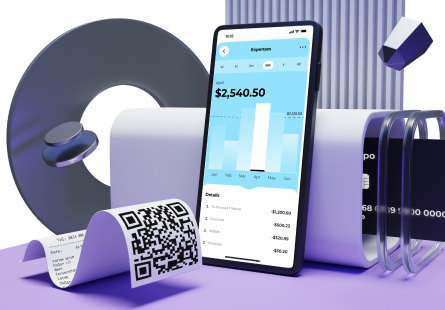Contactless payment methods are gradually replacing traditional ways of paying for goods and services, making e-wallet app development an attractive business choice. Today’s consumers seek convenience, security, and flexibility in managing their finances, and digital wallets offer a seamless solution to match these expectations.
If you’re wondering how to make a contactless payment app, you’re in the right place. This guide explores the key steps of e-wallet app development and provides useful information to inform your decision, so let’s get down to business.
What is a digital wallet, and how does it work?
While digital wallet is a very broad term, in the context of consumer contactless payments – digital wallet, or e-wallet is a software application that securely stores users’ payment data, including bank account information, credit and debit card details, and even cryptocurrencies. Digital wallets enable users to make electronic transactions, both online and in physical stores, removing the need for physical cards or cash.
E-wallet apps can use different technologies to process digital payments:
- NFC (Near Field Communication). This method allows two devices to exchange data when they’re physically close to one another. Two prominent examples of digital wallets using NFC are Apple Pay and Google Pay.
- MST (Magnetic Secure Transmission). MST reproduces a card swipe by wirelessly transmitting magnetic waves to the payment terminal’s card reader. Samsung Pay uses MST along with the NFC technology.
- QR codes. QR codes are two-dimensional barcodes you scan with a smartphone camera to initiate a payment. For instance, you can create a code in the PayPal app to pay for an item in a store.
The most popular types of e-wallets
There are three major types of digital wallets:
Closed wallet
Closed or closed-loop wallets are used within specific ecosystems or businesses, meaning users can use the assets stored to make payment transactions with the wallet issuer only. Examples include Starbucks’ mobile app, Disney’s MagicBand, and Amazon Pay.
Semi-closed wallet
Semi-closed mobile wallets let users make transactions at listed merchants and locations. These wallets are usually associated with a network of merchants or service providers. Users can make payments and transactions within this network but cannot use the semi-closed wallet at businesses outside it.
Open wallet
Open or open-loop wallets are more versatile and can be used across multiple merchants and platforms. They are typically associated with major payment networks like Visa, Mastercard, and American Express.
Some essential mobile payment market statistics
- In 2022, e-wallets accounted for around 50% of e-commerce payment transactions globally.
- The global e-wallet market was valued at $1.04 trillion in 2020 and is projected to increase in size at the annual rate of 20.8% from 2023 to 2030.
- Digital wallets are expected to transact over $16 trillion in payments by 2028.
- 60% of the population worldwide will be using digital wallets by 2026.
Business advantages of digital wallet development
Creating a digital wallet can offer several substantial advantages to businesses across various industries.
Increased customer loyalty
A well-designed mobile wallet application can go a long way toward enhancing brand loyalty by providing customers with seamless payment experiences. Needless to say that users tend to stick with a brand that offers such convenience. In addition, an e-wallet can include loyalty programs and rewards systems, encouraging customers to make repeat purchases and engage with the brand more frequently.
Enhanced customer experience
Mobile wallets streamline the payment process, making it a faster and more convenient payment option, both in-store and online. Moreover, you can use a mobile wallet app to gather data on consumer preferences and utilise it for personalised offers and recommendations.
Cost savings
For businesses that deal with cash, adopting digital wallets can reduce the costs associated with cash handling, such as counting, storing, and securing physical currency.
Higher sales and conversion rates
The convenience of mobile payments often leads to impulse purchases, as customers can quickly complete transactions without entering payment details manually. Also, streamlined checkout processes and the ability to store payment information can significantly reduce shopping cart abandonment rates in e-commerce.
Robust analytics
Digital wallets capture transaction data, which can be analysed to gain insights into consumer behaviour, preferences, and spending patterns. This data can inform product offerings and enable businesses to create more effective marketing campaigns.
Becoming more environmentally-friendly
In addition to cutting down paper currency and receipts, digital wallets contribute to a more sustainable future by minimising resources required for printing, transporting, and handling physical money. By embracing digital payment solutions, businesses feed into a more eco-conscious and resource-efficient economy.
How to build a digital wallet step by step
The process of building a digital wallet involves several crucial phases. From the discovery phase to ongoing maintenance and support, each step plays an essential role in ensuring the success of your digital wallet solution.
Discovery phase
In the discovery phase of digital wallet development, you need to define the business goals you want to achieve with your digital wallet. This phase also involves identifying your target audience and their pain points as well as performing market analysis to assess competition and trends. In addition, the discovery phase suggests outlining the key features and functionalities of the wallet, including payment methods, security measures, integration capabilities, etc.
UI/UX design
User interface and user experience design help produce an intuitive, user-friendly solution. During this phase, UI/UX designers build wireframes, mockups, and prototypes to visualise the wallet’s layout and user interactions.
Development
The development process involves selecting the tech stack to best meet the project’s requirements and building the app’s front-end and back-end. At this stage, e-wallet app developers implement the features defined in the discovery phase, including user registration, payment processing, security features, and integration with payment gateways or banks.
Testing
Rigorous testing is crucial to identify and fix any issues or bugs in the digital wallet. Test specialists conduct various types of testing, including functional testing, security testing, performance testing, and usability testing, and ensure compatibility with different devices, operating systems, and browsers. This phase also involves beta testing with a select group of real users to gather feedback and make necessary improvements.
Launch
Once testing is completed, the e-wallet is prepared for the official launch. This involves submitting the application to app stores and implementing a promotion plan to generate awareness and attract users to download and use the wallet.
Maintenance and support
Mobile wallet app development doesn’t finish once the app hits the market. Ongoing maintenance and support are critical to keep the e-wallet app running smoothly. It’s crucial to regularly update the app, enhance security, and add new features in response to user feedback and changing market needs.
Features to consider when creating a digital wallet
The digital wallet space is highly competitive. If you’re planning to create a digital wallet, it’s important to build a solution that will fully cater to the needs of your target consumers. To help you make a more informed choice, we’ve categorised e-wallet features into must-have essentials and nice-to-have additions.
Must-have features
User registration
A seamless and secure registration process is the foundation of any digital wallet. In the Gen Z era, it’s vital to offer streamlined user onboarding while ensuring data security, so keep this in mind when deciding on the registration method.
Secure user sign-in
Create an extra layer of security by incorporating a user sign-in process with multiple authentication methods, including password, biometric authentication (fingerprint, face recognition), and two-factor authentication (2FA).
Card authorization
Consider utilising tokenization technology to replace sensitive card data with tokens, ensuring more secure transactions. Also, provide your users with added flexibility in payments by allowing them to link multiple debit and credit cards to their wallets.
Bank account integration
It’s critical to ensure that bank account integration is secure and compliant with financial regulations. For this, choose to partner with financial institutions or utilise secure APIs.
Balance check
Make sure your mobile application can provide users with up-to-the-minute balance information, including available funds.
Online payments and transfers
Like physical wallets, e-wallets are supposed to be used for making payments. Besides leveraging NFC technology, provide simple ways to pay for goods and services online. Also, make sure you enable users to send money to friends and family easily, for instance, by using contact details or QR codes.
Transaction history
Offer a detailed transaction history that includes merchant names, timestamps, and transaction IDs. To improve user experience, consider implementing search and filter features.
Analytics dashboards
Analytics dashboards allow for presenting transaction data through interactive charts and graphs for a clear overview of spending patterns.
Push notifications
Make sure your digital wallet application can send real-time alerts for successful and failed transactions, helping users stay informed and secure. You can also utilize notifications to promote special offers, discounts, and loyalty rewards.
Nice-to-have features
AI chatbot
You might have already heard of the growing adoption of AI in banking and the financial sector. You can leverage the potential of this cutting-edge technology by adding an AI-powered chatbot to your mobile wallet app. The bot can provide quick responses to user inquiries, assist with account-related tasks, and offer tailored financial advice.
Loyalty reward offers
When planning your future wallet app, consider incorporating a loyalty rewards program to boost user engagement and customer satisfaction.
Membership cards/discounts
You can offer digital membership cards within your mobile wallet, eliminating the need for physical cards. Also, consider partnering with businesses to integrate exclusive discounts and offers accessible through the wallet.
Wearable integration
Explore wearable device integration, such as smartwatches and fitness trackers, to make contactless payments even more convenient. In addition, you can incorporate advanced features such as tracking steps or monitoring heart rate.
Budgeting tool
You can add a budgeting tool to provide consumers with valuable insights into their spending habits and areas where they can save, as well as enable them to set and track financial goals.
Automatic payments
Deliver rewarding user experiences by streamlining bill payments. You can include automatic scheduling and reminders for recurring expenses like rent, utilities, and subscriptions. If you choose to incorporate this feature, ensure you also maintain a payment history so users can review past and upcoming automatic payments.
Virtual cards management
Offer your users an additional layer of security by enabling them to create virtual cards for one-time or limited-use transactions.
Challenges of digital wallet app development
While building a digital wallet is associated with a number of business benefits, there are some challenges worth taking into account.
Mobile wallet security
While safeguarding user data and financial information is paramount, it’s challenging to meet stringent security standards and encryption protocols. Moreover, the evolving landscape of cyber threats calls for proactive measures to prevent potential breaches.
Solutions:
- Regular security audits and updates
- Encryption of sensitive data
- Customer education on digital wallet security
Regulatory compliance
It’s not a secret that finance is one of the most heavily regulated sectors, meaning that e-wallet apps must comply with numerous regulations and laws, such as AML, GLBA, and JOBS Act in the US and GDPR and PSD2 SCA in Europe. To top it off, legal regulations vary from country to country and sometimes even state to state.
Solutions:
- Staying up-to-date with regulatory changes across your target markets
- Partnering with a fintech development company with experience in regulatory compliance
- Hiring a team of legal experts to help you navigate regulations
Integrations
Integrating an e-wallet with existing payment systems can turn into a significant challenge. Incompatibilities between systems and lack of standardisation can create integration issues.
Solutions:
- Providing multiple payment options
- Partnering with existing payment systems
- Performing thorough testing before launch
Final words
Mobile wallet development is an excellent business choice in a world where people appreciate convenience in everything, financial transactions being no exception. Due to security challenges and a strict regulatory landscape, an e-wallet development project is a complex endeavour. However, with an experienced team of tech professionals by your side, you can create a digital wallet that users will love.
DeepInspire is a software development company with over 20 years of experience building solutions for the financial services sector. Contact us, and we’ll help you create a digital wallet that combines the latest technology with industry best practices to enhance your brand’s presence in the digital age.







